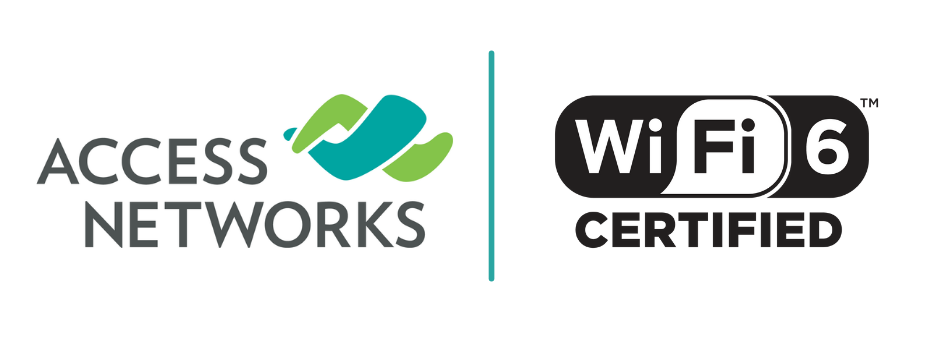The Access Blog
Access Networks Execs Explains Wi-Fi 6 In-Depth
Categorized: The Access Blog | January 13, 2021

CE Pro virtually sat down with Bryce Nordstrand, CEO, and Nathan Holmes, director of training and development, Access Networks, to discuss what Wi-Fi 6 means for integrators, the sales opportunities it presents, and much more.
What exactly is Wi-Fi 6 and why is it such a big deal?
Nathan Holmes: Wi-Fi 6 is the first fundamental rewrite of Wi-Fi since it was first created 23 years ago in 1997. Wi-Fi 6 was really designed to correct a lot of the issues that they’ve found in Wi-Fi over the last 20+ years.
It’s not so much about a massive increase in speed. Wi-Fi 6 is only about a 50% increase in speed, but it represents a significant increase in stability. The way the devices communicate, especially in home environments where there’s a lot of reflection, can make it difficult for stable connections. Wi-Fi 6 borrows technology from the cellular world and brings it into the Wi-Fi world to allow multiple devices to communicate simultaneously with increased stability between the access points (AP) and the client devices, and to enable devices to not have to wait as long to communicate back to the APs. So there are a lot of things that make the protocol more efficient.
Bryce Nordstrand: Also, one of the big changes is that Wi-Fi 6 covers 2.4GHz technology, not just 5GHz as we’ve seen in the past couple iterations of Wi-Fi (802.11n and 802.11ac). The 2.4GHz spectrum is where we anticipate seeing many more client devices hitting the market in the future.
Holmes: With Wi-Fi 6, integrators’ clients won’t have to compete with their neighbors anymore in the 2.4GHz spectrum. Right now, multiple houses right next to each other could conceivably all be on the same 2.4GHz channel, which means only one device in each of our houses can communicate at the same time.
With Wi-Fi 6, if multiple houses are on the same channel the device will know and it will allow communication within the proper home network. This is why companies like Nest, Ring and others are going to capitalize on Wi-Fi 6 with 2.4GHz devices in high-density areas.
Does Wi-Fi 6 represent a sales upgrade opportunity for integrators?
Nordstrand: There is still a lot of really good Wi-Fi technology in homes that is still relevant depending on the devices. But new devices like the iPhone 11 and iPhone 12 and the Samsung Galaxy mobile phones will benefit from having Wi-Fi 6 access points deployed in the home. It’s still going to be a while before we see a proliferation of IoT devices that have the Wi-Fi 6 standard built into them, but in the cutting-edge custom electronics industry, there are a lot of early adopters.
There’s really no reason for an integrator not to install Wi-Fi 6 technology in their clients’ homes, especially now with the opportunity so great due to the increase in work-from-home and school-from-home situations.
Also, elevated performance is especially vital in relation to high-performance luxury products. It’s not about just meeting the standard, but going above and beyond the standard. That’s why they buy expensive speakers and the best TV. The same applies to Wi-Fi.
What is the coverage area of Wi-Fi 6 versus Wi-Fi 5?
Holmes: It really depends on the environment, but in general Wi-Fi 6 APs cover a maximum of 1,800 square feet. That’s a 10% reduction from Wi-Fi 5 because you need much more signal to be able to produce these new data rates and connectivity. Integrators should plan for one AP for every 1,350 square feet because they need to have overlap in their coverage areas. In general, you want to be within 20 feet of an access point no matter where you are inside or outside the home.
What are Access Networks’ Wi-Fi 6 offerings?
Nordstrand: We have three different Access Networks’ access points covering three price points that are Wi-Fi 6 capable. The A750 AP ($1,500) has been out for quite some time. We also have the new A550 ($900) and the A650 ($1,200) that just came out. They are both available as either a standard version or an unleashed version, which runs a controller firmware on it. The standard version will work with a couple of separate controller solutions… either hardware-based or our cloud-based solution. We also have an outdoor solution coming in Q1. We are really the go-to solution for integrators with three Wi-Fi 6 products available and more coming down the pipeline.
Holmes: Most mobile devices manufactured today, such as phones and laptops, use two antennas and two spatial stream configurations (2×2) to balance increased data throughput and long battery life. All of the new Wi-Fi 6 access point support these 2×2 devices, but, the A750 and A650 (on 5GHz only) increase to 4 antennas and 4 spatial streams to send multiple 2×2 transmissions to the same mobile device increasing the stability of the connection.
Does improved performance of Wi-Fi 6 diminish the need for hardwired connections in the home?
Holmes: A hardwired connection will always be a connection of performance, while Wi-Fi is a connection of convenience. If you want the highest performance, you need to use a hardwired connection.
Where does Wi-Fi 6 stand in terms of capabilities to 5G?
Holmes: For the past three years we have heard all this buzz about 5G, but what everyone has discovered is that 5G cannot take you the last mile into the home effectively. Wi-Fi 6 gives you the same level of performance inside the home that 5G provides when you are away from your home.